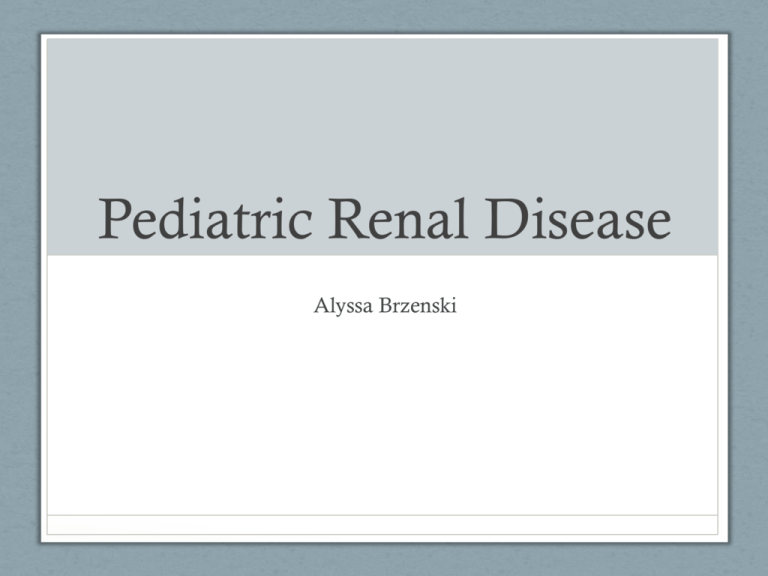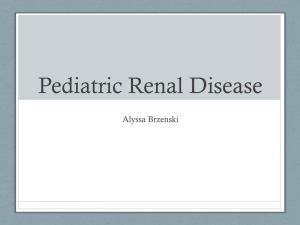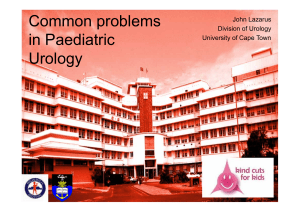Pediatric Renal Disease - UC San Diego Health Sciences
advertisement

Pediatric Renal Disease Alyssa Brzenski Case #1 • A 33 year old female G2P1 at 20 weeks presents for evaluation of fetal bladder distention which was found on routine prenatal ultrasound. There were no other abnormalities found. The mother wants to know what is the prognosis and what interventions she should undergo. Posterior Urethral Valve • 1:5,000 births • 1:2,500 prenatal ultrasounds • Most common obstructive uropathy Long term Side Effects • Renal Scaring • Renal Failure • Decreased amniotic fluid • Pulmonary Hypoplasia Prenatal Ultrasound Theories of Etiologies • Hypertrophy of the urethral ridge • Persistence of the urogenital membrane • Abnormal development of the wolffian or mullerian duct • Fusion of the posterior urethral ridge Work-up- Voiding Cystourethrogram Antenatal Intervention Effectiveness of Antenatal Intervention on Survival Effectiveness of Anetnatal Intervention on renal function Outcomes • Perinatal Mortality • Renal Function at 4-6 weeks • Serum Cr • Renal Ultrasound • Need for Dialysis/Transplant • Renal Function at 12 months Prune Belly Syndrome • 1:40,000 births • Weak abdominal muscles • Weak cough • Associated with • Orthopedic defects (Congenital Hip Dislocation and Scoliosis) • GI (malrotation and volvulus) • Heart (TOF, VSD) • Trisomy 18 and 21 Case 2 • 8 month old male presents to ED with fever of 102.8 and tachycardia. On initial work up a straight cath was performed which demonstrated a UTI. How should this child be evaluated? Vesicoureteral Reflux • Present in 0.5-2% of children • May present with recurrent UTI or may be asymptomatic • Most resolve without treatment Grading Prevalence in Siblings Prevalence with Hydronephrosis in Utero Current Management Guidelines Goals of Treatment • Prevent recurrent UTI • Prevent Renal Damage/scarring • Minimize the morbidity of treatment and followup Antibiotic Prophylaxis • Less than 1 years old • Febrile UTI- Antibiotic prophylaxis • Afebrile UTI with Grade III-V reflux- Antibiotic Prophylaxis • Afebrile UTI with Grade I or II reflux- may offer antibiotic prophylaxis • Older than 1 years old • Febrile UTI- conservative management or antibiotic prophylaxis • Recurrent UTI- start antibiotic treatment or if on antibiotics surgical treatment Who needs surgery? • Children with recurrent infections despite antibiotic prophylaxis • Children who have developed renal scaring or poor renal function • Severe reflux (Grade V or bilateral IV) • Mild to moderate reflux that persists as the patient approaches puberty Deflux Injections • GA for cystoscopy • Submucosal Injection of Deflux (dextranomer microspheres and hyaluronic acid) • 80-90% success at first injection Ureteral Re-implant • GA • Routine Monitors • Balanced anesthetic • Epidural or Caudal for post-op pain management and to reduce post-op bladder spasm Case 4 • 5 year old, 15kg, female with chronic renal failure, secondary to polycystic kidney disease, is admitted for a kidney transplant. She is currently on peritoneal dialysis and was last dialyzed yesterday. She has limited exercize tolerance. Labs including potassium are all normal. ECHO was normal. Causes of Pediatric Renal Failure From NAPRTCS Annual Report. 2010. Accessed March 25, 2013 at www.naprtcs.org Causes of Pediatric Renal Failure by Age Pediatric Chronic Renal Disease • CV- HTN, LV thickening, CHF, Volume Overload • Pulm-Volume Overload • GI- Delayed gastric emptying • Heme- anemia, dysfunctional platelets • Endo/Metabolic- Hyperkalemia, hypercalcemia • Growth- Delayed growth Polycystic Kidney Disease • Autosomal Dominant- 90% of cases • Typically presents in adulthood with macrocysts • Autosomal Recessive- 10% of cases • Presents in-utero screening or in early in infancy • Microcysts of the collecting tubules Autosomal Recessive Polycystic Kidney Disease • Affects • Kidneys- 30% progress to ESRD by 1st decade with 58% needing a renal transplant by adulthood • Liver- 50% will develop hepatic fibrosis with seqelae of portal hypertension • May have pulmonary hypoplasia from decreased urine production in-utero Surgical Approach Anesthetic Considerations • Intravenous Induction • Routine Monitors, CVP +/- Aline • Balanced Anesthetic • Epidural for Post-op Pain Control Anesthetic Considerations • On release of the renal artery clamp, have CVP of 10-15 with blood pressure at baseline or 10% higher (may need pRBC or dopamine) • Adult kidney in a small child or infant will require a significant portion of total blood flow, leading to potential hypotension (volume load prior) • Small infants or very sick children should remain intubated, but most children can be extubated in the OR When should we remove a kidney? • Nephrectomy before transplant due to: • • • • • Large proteinuria Refractory Hypertension Recurrent UTI or urosepsis Urolithiasis Polyuria Sources • Williams G, Fletcher J, Alexander S, Craig J. Vesicoureteral Reflex. Journal of American Society of Nephrology. May 2008; 19: 849-62. • Peters C, et al. Summary of the AUA Guideline on Managemnt of Primary Vesicoureteral Reflux in Children. The Journal of Urology. Sept 2010; 184:1134-44. • Bogaert G, Slabbaert K. Vesicoureteral Reflux. European Urology Supplements. April 2012; 11: 16-24. • Skoog S, et al. Pediatric Vesicoureteral Reflux Guidelines Panel Summary Report: Clinical Practice Guidelines for Screening Children with Vesicoureteral Reflux and Neonates/Infants with Prenatal Hydronephrosis. The Journal of Urology.Sept 2010; 184: 1145-51. • Holmes N, Harrison M, Baskin C. Fetal Surgery for Posterior Urethral Valves: Long-Term Postnatal Outcomes. Pediatrics. 2001; 108: 1-7. • Casella D, Tomaszewski J, Ost M. Posterior Urethral Valves: Renal Failure and Prenatal Treatment. Internation Nephrology. 2012; 1-4. • Uejima T. Anesthetic Management of the Pediatric Patient Undergoing Solid Organ Transplantation. Anesthesiology Clinics of North America. 2004; 22: 809-23. • Sharbaf F, et al. Native Nephrectomy prior to Pediatric Kidney Transplant: Biological and Clinical Aspects. Pediatric Nephrology. 2012; 27: 1179-88. • Dell K. The Spectrum of Polycystic Kidney Disease in Children. Adv Chronic Kidney Disease. 2011; 18: 339-47.








